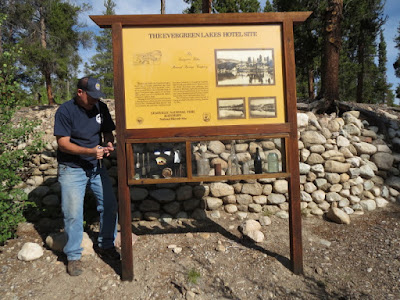One of the ongoing activities from June through mid-July was the spawning of the Cutthroat Trout here at the hatchery. Spawning took place on a weekly basis, since not all of the fish were "ripe" at the same time. We assisted with spawning six different times, but didn't get a lot of pictures as we were busy!!
In simple terms, the ripe females have their eggs squeezed out of them by a biologist, and then the eggs are fertilized by milt that is squeezed from a male or males.
 |
| Squeezing Eggs from Female |
The biologists separate the males from the females prior to spawning. The females are softer in the belly, and the males are a bit more colorful. But there is overlap, with some "females" turning out to be males, and vice versa.
 |
| Adding Milt from Male |
There are a surprising number of things going on during spawning. Each of the Cutthroat Trout have a PIT (Passive Integrated Transponder) tag embedded in them that is read with a special device. This tag identifies each individual fish and records are kept of which fish are bred. Occasionally the PIT tag is expressed with the eggs, so one biologist stands by to reinsert the tag if necessary.
As the fish are selected and PIT tags read, that data has to be recorded. Teri was the data recorder on the crew. Most days she recorded the information on a laptop, but on the final spawning day no laptop was available so she went old-school.
 |
| Data Recording |
This turned out to be a tricky job as different people were yelling out 5-digit numbers at the same time, along with "male" or "female", and "that one wasn't ripe" or "we lost the PIT tag" or "did we give you that number yet", etc. Apparently Teri was a superstar compared to previous data recorders and never missed a beat.
I ended up being the team gopher, doing anything from netting fish to running eggs to the incubator to testing the pH of different solutions.
 |
| Netting Fish |
Once the eggs were fertilized, they were placed into pails of gently flowing water to "water harden". Within about thirty minutes of being fertilized the eggs would absorb water and become very firm. Once they had achieved this firmness they could be transported without fear of damage.
 |
| Eggs Water Hardening |
Finally, the eggs were placed into an incubator. Some eggs are incubated here at the Leadville Hatchery, while others were transferred to a state hatchery in Salida where the water is warmer and hatching takes place more quickly.
 |
| Incubators |
The fish that hatch from these eggs will be held for at least two years prior to being released. Many will be held at the hatchery for three or more years and spawned to continue to process.
Mark





























